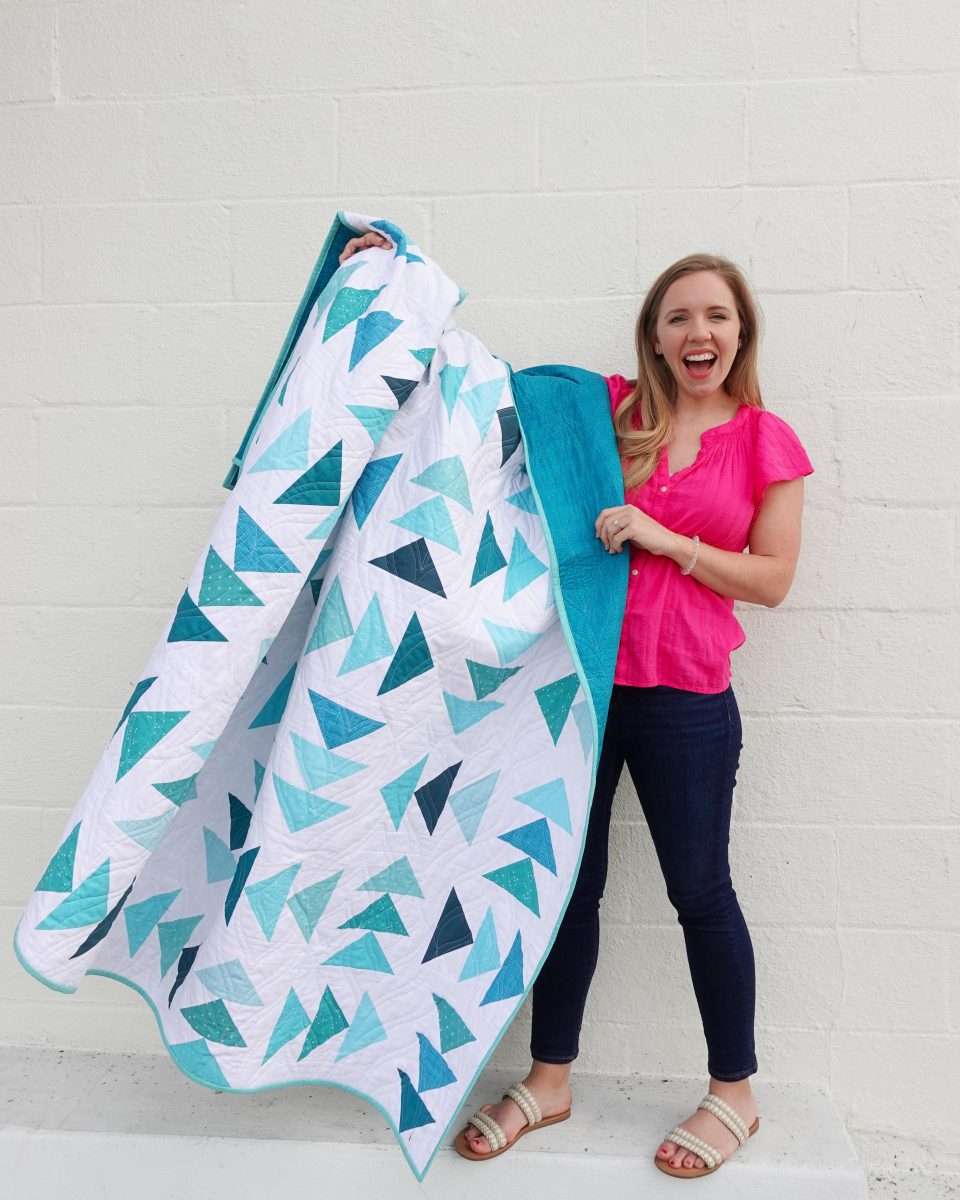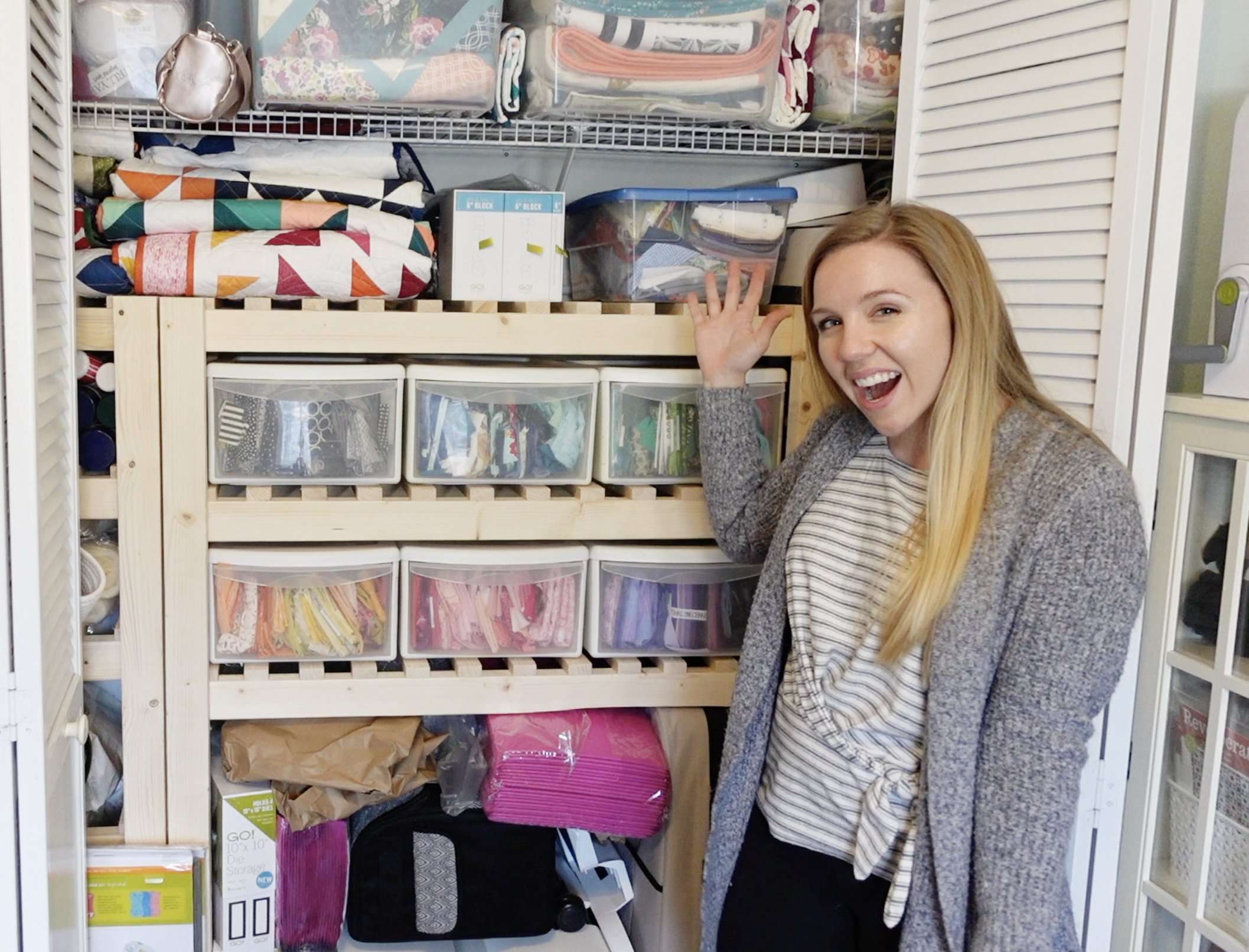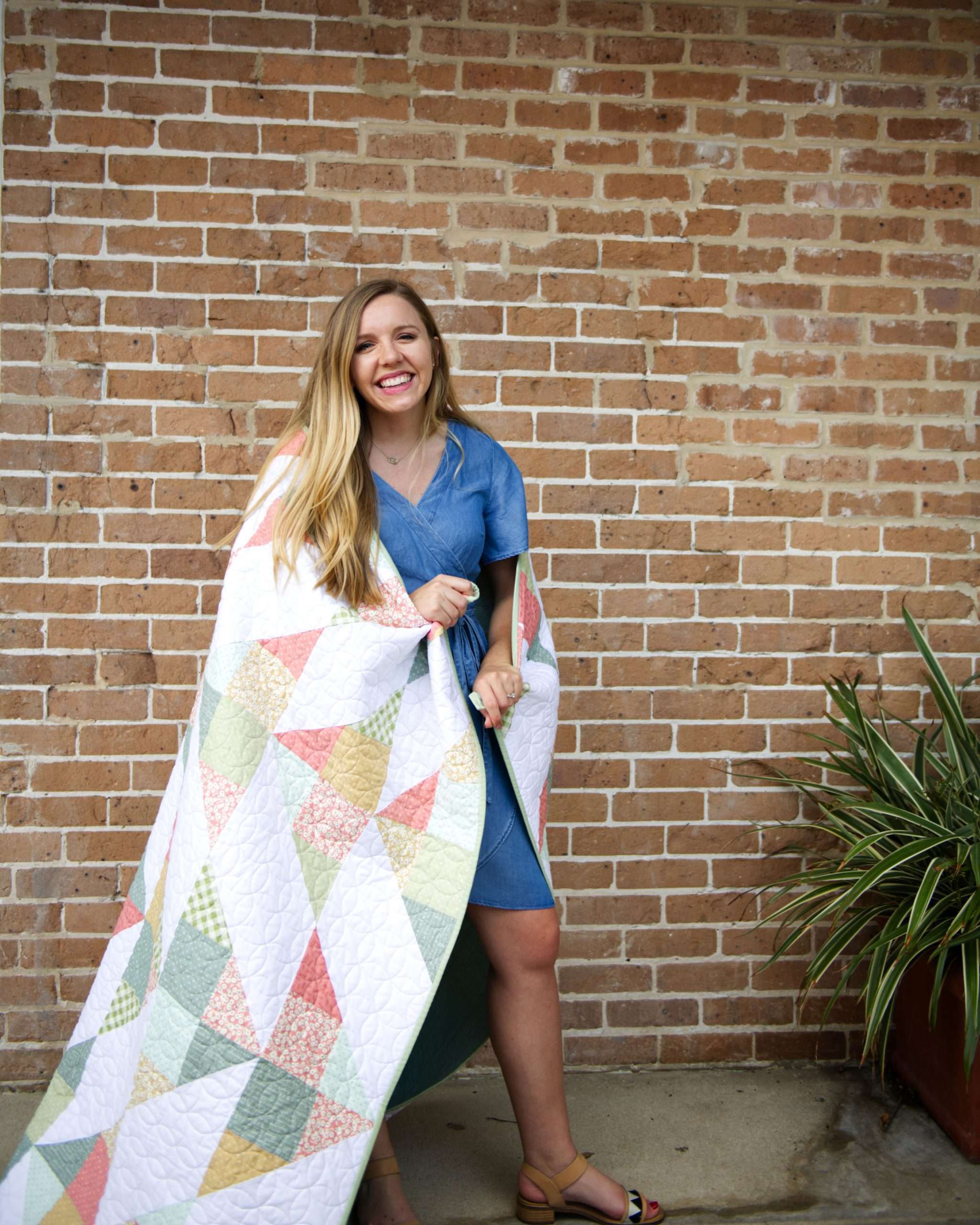Quilt Binding: Part 2 – Machine Sewing Binding On Your Quilt
Alrighty friends, are you ready to sew binding on your quilt?! This article is part 2 in a 3-part Quilt Binding Tutorial series. If you haven’t prepared your quilt and binding yet, head over to read this post and learn what steps I take to make my quilt binding.
To get started, I want to give you two main options for how to bind your quilt in this quilt binding tutorial. The way I first learned from my grandma is the hand binding method. It involved sewing the binding down to your quilt with a machine but then flipping it over and sewing little invisible stitches. Another method is machine quilt binding where you skip the hand sewing and instead use your machine to sew down both sides of the binding. Machine binding is quicker and some find it easier. Whichever method you choose, I hope you challenge yourself to continue learning and enjoy the process!

This article covers how to bind your quilt by machine, and next week’s post will be about TWO different styles of hand sewing the binding onto your quilt. Whichever method you choose, the first few steps are the same!

How to Choose Which Binding Method to Use
Binding your quilt by hand is slow and therapeutic. It creates invisible stitches and ends with a really nice finished look. I love it for some slow stitching to do while watching TV or listening to my audiobooks.
Binding your quilt by machine is getting increasingly more popular, and is a really great way to do it! I personally love it for baby quilts that I know will get a bit of wear & tear as it is more sturdy than hand sewing. I also love that it takes just a fraction of the time!

Quilt Binding Video Tutorial
Watch this video tutorial to learn how to bind your quilt on a sewing machine:
Before You Get Started
The first part of binding your quilt is to trim your quilt and make your binding. Read all my tips here in this article: Quilt Binding Part 1 – Prep Work
Regardless of what sewing method you prefer to use, you’ll sew the first side of your binding down on the machine. Follow the first half of this article for Side 1.

Helpful Tools for Binding Your Quilt on Machine
This is the part in the article where I tell you all about how much I LOVE my Walking Foot. If your machine did not come with a walking foot, you need to find one that works for it and buy it! I quilted for 4 years before I even knew this foot existed and let me tell you, it’s a total game changer. I use it when quilting straight lines on my quilts, and you-guessed-it, I use it to sew on the binding too! A walking foot, aka “even-feed foot” utilizes feed dogs on the top of your fabric in conjunction with the feed dogs on your machine to pull your fabric through from the top and the bottom, which makes it an amazing tool for any bulky sewing with multiple layers!
Which side to Start On for Machine Quilt Binding
I prefer to sew my binding onto the front first and then flip it to sew the back side second. It’s really a personal decision though for which side you sew on first! For ease of writing this article, I’ll assume you’re also stitching it onto the front first as well.
Sewing Your Binding on the 1st Side
To start, line up your raw edge of your binding with the raw edge of your quilt. Consider pinning it down all the way around to make sure you don’t have any seams of your binding wrapping around at the corners. Having a seam at the corner can create a lot of bulk and result in some wonky corners.


When you are ready to begin sewing, start in the middle of one of the long edges of the quilt. Leave a tail of at least 6″-10″ at the top of your binding, and start sewing the binding at a 1/4″ seam allowance. Sew the rest of the edge, stopping 1/4″ away from the bottom of the quilt. Put your needle down and pivot, sew a diagonal line for the 1/4″towards the corner of the quilt.
The corners are notoriously the trickiest part of binding a quilt, so be careful here to fold crisply for a nice end result. Once you have sewn off the edge of the corner of the quilt, fold your binding straight UP, line it up with the top edge, and then fold down, keeping the crease/fold level with the top edge. Now sew from the very top all the way down in a straight line, keeping at a 1/4″ seam allowance.




Continue the above method, sewing around all edges of the quilt, completing all 4 corners, until you are about 12″ away from where you started sewing. Next you will join your binding ends to make it continuous.
Join the Binding Ends Together
Overlap your binding extras and trim them so there is a 2.5″ overlap in the center of your un-sewn section of the quilt binding. (or 2.25″ if that is how wide your binding strips are). Twist each end of the binding 90 degrees, with right sides together, to create a similar diagonal seam as you did before when joining binding strips.




Pin along the anticipated seam line and pull open to make sure the diagonal is going in the right direction before sewing it. Once it’s pinned, gently pull it open to make sure things are set like how you want them to be sewn. Sew on the diagonal line and trim the excess corners to make a 1/4″ seam allowance. Press to make a completely flat folded over binding. It should fit perfectly in your un-sewn space on the quilt. Finish that edge with a 1/4″ seam allowance, making your binding completely continuous.

Once your binding is sewn onto the top of your quilt all the way around on the front, you flip it over to attach the binding to the back.

Baste your Binding to the Back of the Quilt
My top secret for successfully sewing your binding onto your quilt is to baste it really well. For basting your binding down, you’ll need tacky glue and an iron. The tacky glue holds everything together for you, and setting with an iron makes it dry super fast. You don’t need much glue, just a super thin line close to the edge.
First, use your hot iron to press your binding up, and then fold it over and press it again into place. Next, add a thin line of glue, and press it with the iron to set the glue. Repeat this process all the way around the quilt. It’s a tad bit time-consuming but if you do it right it will be SO WORTH IT when it comes time to sew it down.


Machine Sewing the Binding onto the Quilt Back
The next step is to machine sew around all edges of the quilt. I personally like to sew with the front side up and try to hide my stitches in the ditch where the binding was originally attached. If you basted well, this part will be easy! The stitches will go right through all layers of binding and leave a really nice looking finished edge!

The best tip for making sure your stitches are as unnoticeable as possible on the front is to stitch in the ditch VERY SLOWLY. I like to go at about 1/2 speed for this so i can keep a nice, even, straight line of perfect stitches.





Never miss a post! Be sure to subscribe to the newsletter and follow @homemadeemilyjane on Instagram.
Want more project inspiration? Here are a few popular posts:






